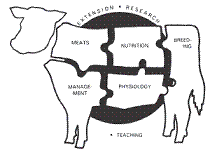Animal Science, Department of

Nebraska Beef Cattle Reports
Date of this Version
2017
Citation
2017 Nebraska Beef Cattle Report. University of Nebraska Extension MP104. Lincoln, NE.
Abstract
The effects of three harvest methods, both with and without ammonia treatment, on the in vivo digestibility and intake of baled corn residue were assessed in a digestion trial with lambs. Treatments included three corn residue harvest methods (conventional rake and bale, New Holland Cornrower™ with eight rows or with two rows of corn stalks chopped into the windrow containing the tailings [leaf, husk and upper stalk] from eight harvested rows) and the effects of ammoniation at 5.5% of DM compared to no ammoniation of the residue. Th e 2- Row baled residue (51.7%) had greater dry matter digestibility than both 8- Row (47.3%) and CONV (44.7%). Ammoniation increased dry matter digestibility by 24% (10 percentage units) across all residue types. Additionally, ammoniation increased intake. Utilizing alternative harvesting technologies and ammoniation can improve the digestibility of baled residue. These effects are additive and combining the two technologies resulted in the greatest improvement in digestibility.
Included in
Large or Food Animal and Equine Medicine Commons, Meat Science Commons, Veterinary Preventive Medicine, Epidemiology, and Public Health Commons


Comments
© 2016 The Board Regents of the University of Nebraska.